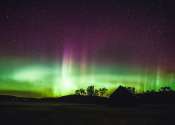New study shows mysterious solar particle blasts can devastate the ozone layer, bathing Earth in radiation for years
The remarkable aurora in early May this year demonstrated the power that solar storms can emit as radiation, but occasionally the sun does something far more destructive. Known as "solar particle events," these blasts of ...









